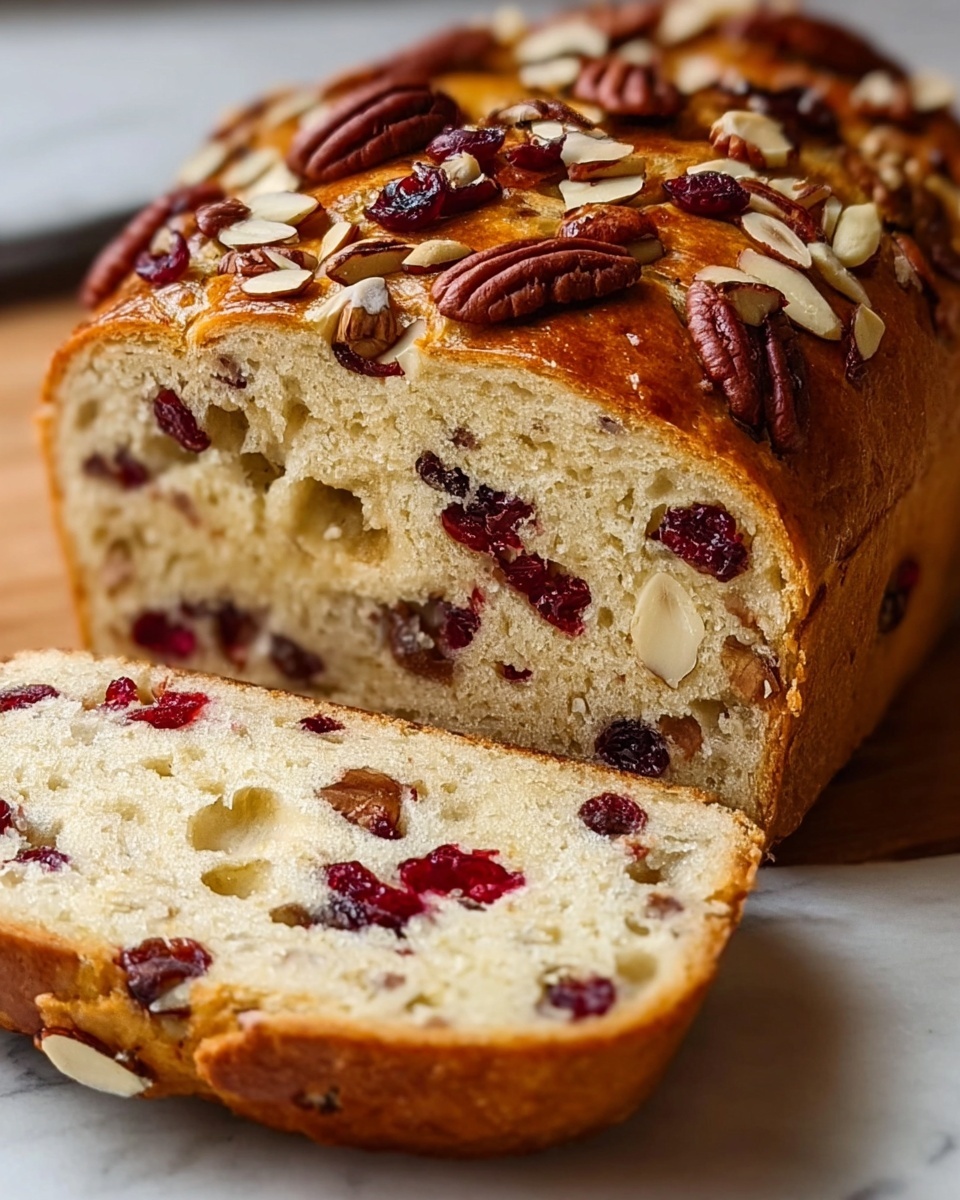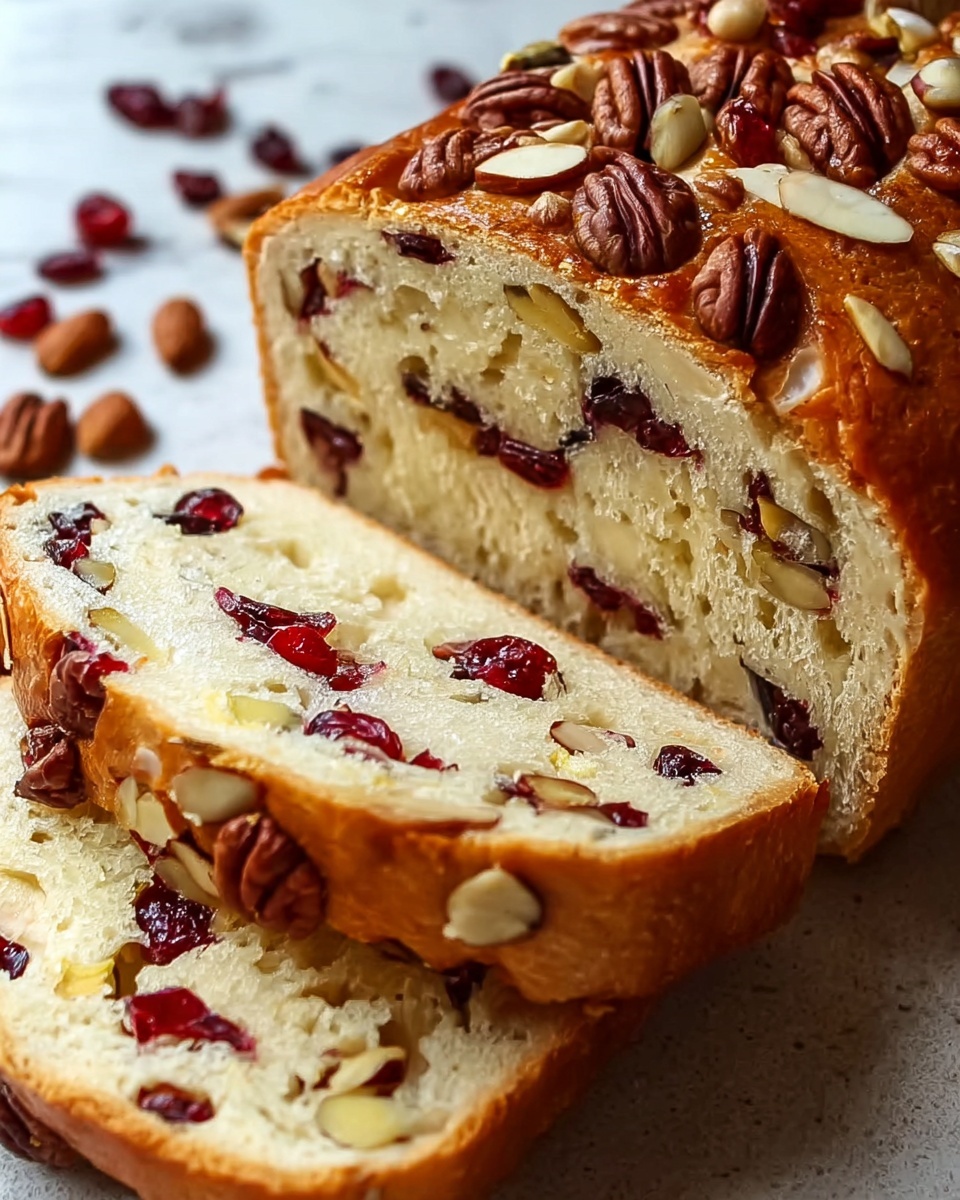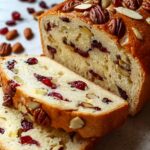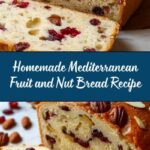If you’re searching for a bread recipe that bursts with wholesome flavors and a delightful mix of textures, the Mediterranean Harvest Bread with Fruit and Nuts Recipe is going to become your new favorite. This beautiful loaf combines the natural sweetness of dried fruits with the satisfying crunch of nuts and seeds, all wrapped up in a fragrant herbed dough that’s both rustic and refined. It’s perfect as a breakfast treat, a snack with tea, or a stunning accompaniment to a cheese board. Trust me, once you bake this Mediterranean Harvest Bread with Fruit and Nuts Recipe, you’ll want to share it with everyone you love.

Ingredients You’ll Need
These ingredients may seem simple, but each one plays a crucial role in building the bread’s characteristic taste, texture, and aroma. From the flour that forms the hearty base, to the dried fruits and nuts that add bursts of flavor and crunch, every component is essential.
- All-purpose flour (3 ½ cups / 440g): The foundation of your dough, providing structure and softness; whole wheat flour works beautifully for a nuttier taste.
- Salt (1 teaspoon): Enhances the overall flavor and balances the sweetness.
- Sugar or honey (2 tablespoons): Feeds the yeast and adds a touch of sweetness.
- Active dry yeast (2 teaspoons): The magic ingredient that helps the bread rise and develop a light crumb.
- Warm water (1 ¼ cups, about 110°F / 43°C): Activates the yeast and brings the dough together.
- Olive oil (2 tablespoons): Adds moisture and a subtle Mediterranean flavor.
- Dried rosemary (1 teaspoon): Brings herbal depth; thyme is a lovely substitute.
- Ground cinnamon and nutmeg (1 teaspoon each, optional): Warm spices that add just a hint of cozy complexity.
- Dried apricots and figs (½ cup each, chopped): Sweet and chewy fruit pieces that give the bread its “harvest” character.
- Raisins or sultanas (¼ cup): Adds bursts of natural sweetness throughout.
- Dried cranberries (¼ cup, optional): A tart contrast that brightens the flavor.
- Walnuts (½ cup, roughly chopped): Provide a satisfying crunch and earthy taste; almonds or pecans are great alternatives.
- Hazelnuts (½ cup, optional, roughly chopped): Introduce extra crunch and a toasty note.
- Sunflower or pumpkin seeds (2 tablespoons, optional): For an additional textural layer and crunch.
- Orange zest (1 tablespoon, optional): Infuses the bread with a bright citrus aroma.
- Honey (1 tablespoon, optional): A gentle glaze of sweetness.
- Coarse sea salt (1 tablespoon): Sprinkled on top for a salty finish that contrasts beautifully with the fruit.
- Fresh rosemary sprigs (a few, optional): For garnish and an aromatic touch.
- Olive oil (1 tablespoon, for brushing): To achieve a glossy, golden crust.
How to Make Mediterranean Harvest Bread with Fruit and Nuts Recipe
Step 1: Prepare the Dough
Start by activating your yeast. In a small bowl, mix the warm water, sugar or honey, and dry yeast. Stir gently until your sugar dissolves, then let the mixture rest for about 5 minutes until it becomes frothy—this means your yeast is alive and ready to work its magic.
Step 2: Mix the Dry Ingredients
In a large bowl, combine the flour, salt, dried rosemary, cinnamon, and nutmeg if you’re using it. Create a well in the center of the mixture, which will make it easier to incorporate the wet ingredients evenly.
Step 3: Combine Wet and Dry Ingredients
Pour the yeast mixture and olive oil into the well you made. Stir with a wooden spoon, gradually bringing the dough together. If it feels too sticky, sprinkle in a little more flour as you knead. Transfer to a clean surface and knead for about 8-10 minutes until your dough feels smooth and elastic—this step is vital for building the structure that traps the rising air.
Step 4: Add the Fruit and Nuts
Now for the fun part! Gently knead in all the dried fruits, nuts, seeds, and orange zest if using. Take your time here, aiming for an even distribution so every slice packs that perfect balance of sweet and crunchy. The dough will be slightly sticky from the fruits, but don’t be tempted to over-flour it.
Step 5: First Rise
Shape the dough into a ball and place it in a bowl lightly greased with olive oil to prevent sticking. Cover it with a clean towel or plastic wrap and find a warm spot in your kitchen. Let it rise for 1 to 2 hours until it doubles in size, signaling that all the fermentation and flavor development has begun.
Step 6: Shape the Dough
Once risen, gently punch down the dough to release excess air, then shape it into a round or oval loaf. Place it on a parchment-lined baking sheet or a greased round bread pan, preparing for its final rise.
Step 7: Second Rise
Cover the shaped dough again and allow it to rise for 30 to 60 minutes. It should puff up nicely, almost doubling again, getting ready for that perfect oven spring.
Step 8: Preheat the Oven
Heat your oven to 375 degrees Fahrenheit (190 degrees Celsius). Preheating is essential so that when your dough goes in, it will bake evenly and develop a gorgeous crust.
Step 9: Bake
Brush the top of your loaf with olive oil to encourage browning and sprinkle with coarse sea salt for contrast. Bake for 35 to 40 minutes until the bread turns a rich golden brown and sounds hollow when you tap the bottom. For a fragrant finishing touch, add a few sprigs of fresh rosemary on top during the last ten minutes of baking.
Step 10: Cool Before Slicing
Patience is key here. Let the bread cool completely on a wire rack before slicing. This resting period lets the crumb set perfectly so your slices won’t fall apart and the flavors settle beautifully.
How to Serve Mediterranean Harvest Bread with Fruit and Nuts Recipe

Garnishes
For a stunning presentation, lightly brush slices with honey or olive oil after toasting, and sprinkle a few fresh herb leaves like rosemary or thyme. A little extra crunch from toasted nuts on top adds elegance and texture.
Side Dishes
This bread pairs wonderfully with creamy cheeses such as goat cheese or ricotta, drizzled with a touch of honey. It also shines beside a bowl of warm soup or a fresh, vibrant salad, making it versatile for any meal.
Creative Ways to Present
Try slicing the Mediterranean Harvest Bread with Fruit and Nuts Recipe into thick pieces and serving as part of a charcuterie board layered with slices of cured meats, soft cheeses, olives, and fresh figs. To wow guests, offer it toasted with a smear of almond butter or ricotta and a sprinkle of cinnamon.
Make Ahead and Storage
Storing Leftovers
Wrap your leftover bread tightly in plastic wrap or place it in an airtight container at room temperature. It will stay fresh for up to 3 days; keep it away from heat or moisture to preserve its texture.
Freezing
This bread freezes beautifully. Slice and wrap individual pieces or the entire loaf tightly in plastic wrap, then place in a freezer bag. It can be frozen for up to 3 months without losing flavor or texture. Defrost at room temperature before enjoying.
Reheating
To restore that freshly baked warmth and crisp crust, pop slices in a toaster or warm whole loaf in a 350°F (175°C) oven for about 10 minutes. Brushing the crust lightly with olive oil before reheating enhances the flavor and moisture.
FAQs
Can I use different dried fruits and nuts in this Mediterranean Harvest Bread with Fruit and Nuts Recipe?
Absolutely! The bread is wonderfully flexible. Feel free to substitute any dried fruits or nuts you prefer or have on hand — like dates, cherries, almonds, or pistachios — to put your personal spin on it.
Is it better to use all-purpose or whole wheat flour?
Both work well. All-purpose flour gives a lighter texture, while whole wheat adds a richer, nuttier flavor and extra fiber. You can even mix the two for a balanced loaf.
Can I make this bread without nuts?
Yes, you can omit the nuts if you have allergies or preferences. The dried fruits alone will still give plenty of flavor and chewiness, though the texture will be less crunchy.
Do I need to proof the yeast every time?
Proofing the yeast in warm water with sugar ensures that it’s active. This step boosts your confidence that the bread will rise properly, although some yeast packets are labeled “instant” and can be mixed directly into the flour.
How do I know when the bread is fully baked?
Look for a deep golden crust and a hollow sound when you tap the bottom of the loaf. Using a digital thermometer, the internal temperature should reach about 190°F (88°C).
Final Thoughts
Baking the Mediterranean Harvest Bread with Fruit and Nuts Recipe is like inviting the vibrant flavors of the Mediterranean right into your kitchen. It’s a recipe that rewards your effort with a loaf that’s as beautiful as it is delicious, perfect for sharing or savoring on your own. I can’t wait for you to try it and fall in love with this delightful balance of sweet, savory, and nutty notes in every bite.
Print
Mediterranean Harvest Bread with Fruit and Nuts Recipe
- Prep Time: 20 minutes
- Cook Time: 40 minutes
- Total Time: 1 hour 5 minutes
- Yield: 1 loaf (about 1.5 pounds or 680 grams)
- Category: Bread
- Method: Baking
- Cuisine: Mediterranean
- Diet: Vegetarian
Description
This Mediterranean Harvest Bread with Fruit and Nuts is a flavorful, rustic loaf enriched with a mix of dried apricots, figs, cranberries, nuts, and aromatic herbs. The bread offers a delightful balance of sweet and savory notes, enhanced by warm spices like cinnamon and nutmeg. Perfect for breakfast, snacks, or paired with cheeses, this bread combines wholesome ingredients and traditional yeast baking for a wholesome treat.
Ingredients
Dough Ingredients
- 3 ½ cups (440g) all-purpose flour (or whole wheat flour for a healthier option)
- 1 teaspoon salt
- 2 tablespoons sugar or honey
- 2 teaspoons active dry yeast
- 1 ¼ cups warm water (around 110°F or 43°C)
- 2 tablespoons olive oil
- 1 teaspoon dried rosemary (or thyme)
- 1 teaspoon ground cinnamon (optional)
- 1 teaspoon ground nutmeg (optional)
Fruit and Nut Mix
- ½ cup dried apricots, chopped
- ½ cup dried figs, chopped
- ¼ cup raisins or sultanas
- ¼ cup dried cranberries (optional)
- ½ cup walnuts, roughly chopped (or almonds or pecans)
- ½ cup hazelnuts (optional), roughly chopped
- 2 tablespoons sunflower seeds or pumpkin seeds (optional, for crunch)
- 1 tablespoon orange zest (optional, for a citrusy hint)
- 1 tablespoon honey (optional, for sweetness)
Finishing
- 1 tablespoon coarse sea salt
- A few sprigs of fresh rosemary (optional, for garnish)
- 1 tablespoon olive oil (for brushing the top of the loaf before baking)
Instructions
- Prepare the Dough: Combine warm water, sugar (or honey), and yeast in a small bowl. Stir until sugar dissolves and let it sit for about 5 minutes until frothy and activated, signaling the yeast is ready.
- Mix Dry Ingredients: In a large mixing bowl, combine flour, salt, dried rosemary, cinnamon, and nutmeg. Create a well in the center of these dry ingredients to prepare for adding liquids.
- Combine and Knead Dough: Pour the activated yeast mixture and olive oil into the flour well. Stir with a wooden spoon until the dough starts to come together. If sticky, add a little more flour. Knead the dough on a floured surface for 8-10 minutes until it becomes smooth and elastic.
- Add Fruit and Nuts: Gently fold the chopped dried fruits, nuts, seeds, and orange zest into the dough. Knead gently for 3-4 minutes to ensure these additions are evenly distributed, resulting in a slightly sticky but cohesive dough.
- First Rise: Shape the dough into a ball and place it in an oiled bowl. Cover with a clean kitchen towel or plastic wrap and let it rise in a warm place for 1-2 hours, or until doubled in size.
- Shape the Dough: Punch down the risen dough to release air bubbles. Shape it into a round or oval loaf. Place the shaped dough on a parchment-lined baking sheet or in a greased round bread pan.
- Second Rise: Cover the shaped dough and allow it to rise for another 30-60 minutes until puffed up and slightly risen again.
- Preheat Oven: Preheat the oven to 375°F (190°C) to ensure it is ready for baking when the dough has risen.
- Bake the Bread: Brush the top of the loaf with olive oil and sprinkle with coarse sea salt. Bake for 35-40 minutes until the crust turns golden brown and the loaf sounds hollow when tapped on the bottom. During the last 10 minutes, optionally add fresh rosemary sprigs for garnish and aroma.
- Cool the Bread: Remove the bread from the oven and allow it to cool completely on a wire rack before slicing to ensure the interior texture sets properly.
Notes
- You can substitute all-purpose flour with whole wheat flour for a heartier and healthier loaf.
- Adjust the amount and variety of dried fruits and nuts to your preference or availability.
- If you prefer a sweeter bread, add a tablespoon of honey to the dough or brush honey on the top after baking.
- Ensure your water temperature is around 110°F (43°C) to properly activate the yeast without killing it.
- The second rise is crucial for light texture; avoid rushing this step.
- Use a sharp serrated knife to slice the bread once cooled to prevent crushing the crumb.
- Store the bread in an airtight container or bread box at room temperature for up to 3 days, or freeze slices for longer storage.








